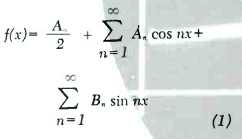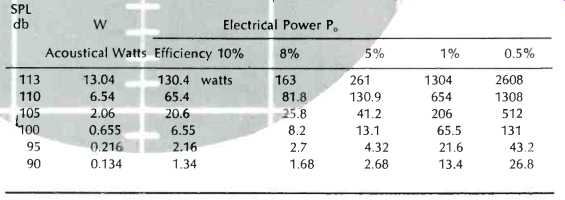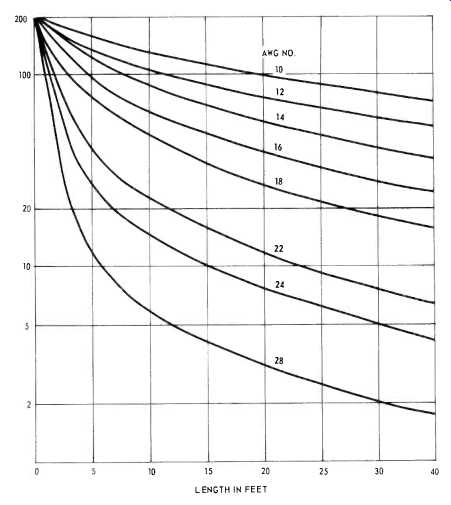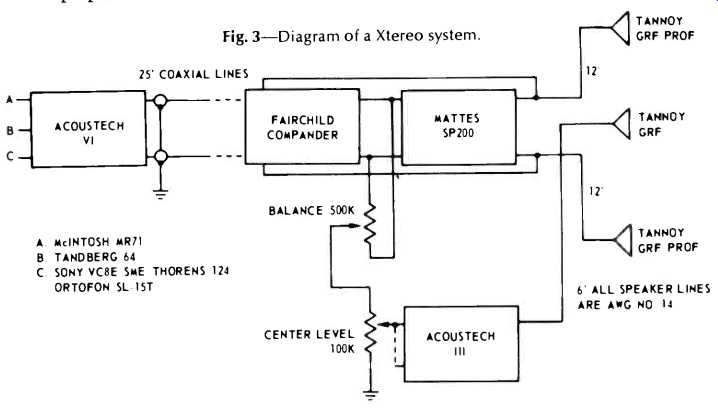by O. S. GODA [Presented at the Stereophonic Club of Southern California meeting of 18 November 1967 in Orange, Calif.]
This paper will present theoretical and practical aspects of simulating a concert orchestra in a home by means of state-of-the-art audio components. Emphasis will be placed on the transient characteristics of music, quality of components, room acoustics, and especially transient power capabilities of amplifiers and speakers. Transient power is very important because the dynamic range of a room background noise to the stimulated full concert orchestra may be from 60 to 70 decibels. The home audio system should be capable of handling this dynamic range. The Xtereo system uses three speakers driven separately by solid-state power amplifiers.
Transient responses of musical instruments can be represented by Fourier transform:

(1)
First and second terms of Eq. (1) represent even harmonics while the third term represents odd harmonics.
When n=1, the wave form consists only of the fundamental. It is known that n must equal up to nine in order to describe a transient pulse truly. Any transient waveform can be reduced to sinusodial waveforms by knowing its amplitude, harmonic relation, and phase.
If the highest fundamental of a musical instrument were 4 kHz, and up to the 7th harmonic were required to reproduce the instrument, we immediately require a bandwidth of 28 kHz. Some present manufacturers still claim that 20 kHz is adequate for musical reproduction. This may be partially true if one were to take only the frequency into account. However, phase relations must be considered.
A 0.5 and 1dB change in the edge response constitute respectively 20 and 27deg. phase shifts. After about 8 kHz, this phase shift for the higher harmonics can change the original waveform unless the bandwidth of the whole stereo system is beyond 50 kHz.
An ear cannot respond to 50 kHz or 150 kHz. However, an ear can detect what is happening to the particular sound up to medium frequency (20 kHz) due to frequency limitation or, more seriously,, phase distortion.
If one accepts the fact that a wide bandwidth system is needed, this can be easily related to transient rise time of any linear amplifier.
tr=0.35/freq. at -3 dB (2)
This is the reason why modem solid-state amplifiers with extremely wide frequency bandwidth can realistically reproduce transient waveforms.
According to measurements conducted by Luce and Clark', the transient-attack time of the highest musical note is approximately 1 millisecond where the transient attack time is defined as that period from the beginning of the signal to the point at which the magnitude is 3 dB down (0.707) of the magnitude) .
If the average listening level for a classical music were 0.25 acoustic watts, and the peak output of a full concert orchestra can develop up to 17 dB above this average or equivalent to 50 times, then 12.5 watts acoustic power will be developed. A concert orchestra is semi-stereo. If one were to attempt to reproduce this orchestra, a wall of speakers will be required.
This is impractical. Therefore, a good compromise which excels the present stereo system is the three speaker system.'' The advantage of the three speaker system over the two speaker system is beyond the scope of this paper. In general, it can definitely be stated that full stereo is unrealistic and restricts the listener's position; and the three speaker system improves this situation. Tappan's paper states that for proper acoustical balance from a three speaker stereo (Xtereo) system, the center speaker should have at least 6 dB less power. An 8dB differential has been selected or 0.159 the power of the left or right speaker in this system by 440Hz and 1000Hz audio signals and various musical program materials. This means that most of the power must be developed from the left and right speakers (1-0.159) x 156 watts =131 watts.

Table 1. Sound Pressure Level and Electrical Power for Speaker Efficiency

Fig. 1--Sound pressure levels (SPL) in decibels with respect to 0.0002 microbars.
The Journal of the Acoustical Society of America has studied and measured the acoustical power outputs of various orchestral instruments. In this study, the maximum absolute output as well as the frequency range in which they occurred were determined.` The power output of a piano was between 0.42 to 0.69 acoustic watts, with the greatest power being distributed in the 250to 400Hz range.
Acoustical terminology will be defined and related to an actual system.
The sound pressure level is 20 times the logarithm of the ratio of the measured effective sound pressure to the reference sound pressure. The reference sound pressure Pref=0.002 micro bar.
SPL=20log (p/p ref )dB (3)
The acoustic power level of a sound source is 10 times the logarithm of the ratio of the acoustic power radiated to the reference acoustic power.

(4)
Where W =acoustic power in watts
Wr =reference acoustic power of 10 watts
The exact method° is beyond the scope of this paper. However, a simplified expression of Eq. (3) which includes the sound absorption coefficient of a room is

(5)
Where PWL=Eq.(4)
Sw =area of radiating wall in ft^2
R =aS/(1-a)
Sw =total area of all surface of the room in ft^2
a=average absorption coefficient of the room
The second term of Eq. (5) has a negative sign because S. and R are much greater than unity. From reference 6, the average absorption coefficients are:
Dead room a=0.40
Medium dead room a=0.25
Average room a=0.15
Medium live room a = 0.10
Live room a=0.05
The average absorption coefficient can be calculated by

(6)
Where S1, S2, and Sn are the areas of particular absorbing surfaces in ft'; and a a and a, are the absorption coefficient associated respectively with these areas. The absorption coefficient of materials such as walls (brick, plaster, wood), floor (wood, tile, carpeted) , draperies, and furniture (un upholstered, upholstered) are all variable; and each particular material varies in absorption coefficient from 125 Hz to 4000 Hz. Also, the number of people and how they are dressed are variables and frequency dependent.
For an average room of size 11 x 15 x 22 ft, the distance at the conductor's podium, Eq. (5) is used to determine the peak acoustic watts.
10 log W=113-130.5+28.66 =11.66 dB (7)
Solving for the acoustic power
W=log^-1 (11.6/10) =1304 acoustic watts (8)
The electrical power requirement of an amplifier-speaker system is shown by Table I for various SPL which can be related to Fig. 1. If one were seated 20 feet from a large orchestra, Fig. 1 shows that SPL=96 dB; then the electrical power output from the power amplifier can be low for high-efficiency speakers. However, the power amplifier may be approaching the point of high intermodulation distortion and harmonic distortion for very-low-efficiency speakers. For the acoustic room considered and the recording technique used, it can be seen that a low efficiency speaker cannot possibly duplicate a concert orchestra at the conductor's podium. This is because power amplifiers with one kilowatt undistorted power output or even 600 watts are not available. Published data on low-frequency distortion for an acoustically suspended speaker are relatively high at the 20-watt level.
Damping factor (DF) is the ratio of the load impedance (normally referred to 8 ohms) to the internal source impedance of a power amplifier. A good tube amplifier may have a DF of 25. However, quality solid-state power amplifiers may have a DF of over 200; this means less than 0.04 ohms internal impedance. Any transmission line that is connected between the power amplifier and the speaker should not significantly reduce the DF. Since the speaker is an electromechanical device that has movement for a particular sound wave, it will have a normal reverse movement unless the impedance at the speaker terminals can damp out the reverse movement. If the speaker lines were of small size and/or appreciable length, this increases the effective output impedance and the designed DF is essentially lost. Figure 2 shows the effect of DF versus speaker line length for various AWG number wire. A DF of 200 is assumed for a solid-state power amplifier. It shows the importance of separate power amplifiers that are placed as close as possible to speakers with proper AWG wire and short lines.
In this respect, the physically separated preamplifier should have a low output impedance, approximately 200 ohms, with shielded signal lines. Previously, audio buffs have stated that with high-efficiency speakers, speaker lines are not important because little power is lost in the line. This is true at low power levels and no consideration given to DF. In the low-efficiency acoustically suspended speakers where the speaker cone must move a greater distance at low frequencies, Fig. 2 is very significant.

Fig. 2--How damping factor is affected by gauge and length of speaker cables.

Fig. 3--Diagram of a X-tereo system.
Figure 3 shows the author's Xtereo system. Mattes SP200 and Acoustech III solid-state power amplifiers and a Fairchild Compander are placed on the top of the monaural center Tannoy GRF speakers for damping factor consideration. The left and right flanking Tannoy GRF Professional speakers are separated by 12 to 15 feet center-to-center with toe-in capability. The center channel is derived at the input of the main solid-state power amplifier.
Thus, volume expansion can be obtained on all three channels. Center channel balance or simulated electrical movement of the third speaker is accomplished by the balance control.
The center channel is controlled by the level potentiometer. Twenty-five feet of miniature coaxial lines (RG/174-U) connect the Compander to the low impedance outputs of the Acoustech VI preamplifier. At the control center, miniature coaxial lines of short lengths are used to connect the preamplifier to a McIntosh MR71 tuner, Thorens TD124 turntable with a SME arm and an Ortofon SL15T cartridge, and a Tandberg 64 tape deck. The tape deck has been equalized to Scotch type 201 and 203 low-noise tapes.
During the demonstration with Beethoven's Symphony No. 7 by William Steinberg, Mahler's Symphony No. 2 by Georg Solti, and Saint-Saens' Symphony No. 3 by Eugene Ormandy, the peak transient power was 55 watts each for the left and right speakers measured with a Tektronix type 547 oscilloscope.
REFERENCES
D. Luce and M. Clark, "Duration of attack transients of non-percussive orchestral instruments," J.A.E.S., Vol. 13. No. 3, July 1965, pp. 194-199.
R. A. Greiner, "Power amplifier overload characteristics and their importance," AUDIO, June 1966, pp. 19-23.
P. W. Klipsch, "Experiments and experiences in stereo," IRE Trans. on Audio, Vol. AU8 No. 3, May-June 1960, pp. 91-94.
W Tappan, "An improvement in simulated three-channel stereo," IRE Trans. on Audio, May-June 1961, pp. 72-79.
L. L. Beranek, "Acoustics," McGraw-Hill Book Co., 1954, pp. 298-324.
Percent distortion versus frequency for an AR3 speaker. Acoustic Research, Inc. 24 Thorndike St., Cambridge, Mass.
(Audio magazine, Feb. 1970)
Also see:
Equalization of Sound Reinforcement Systems (Nov. 1972)
Psychology of Sound Reproduction (June 1972)
= = = =